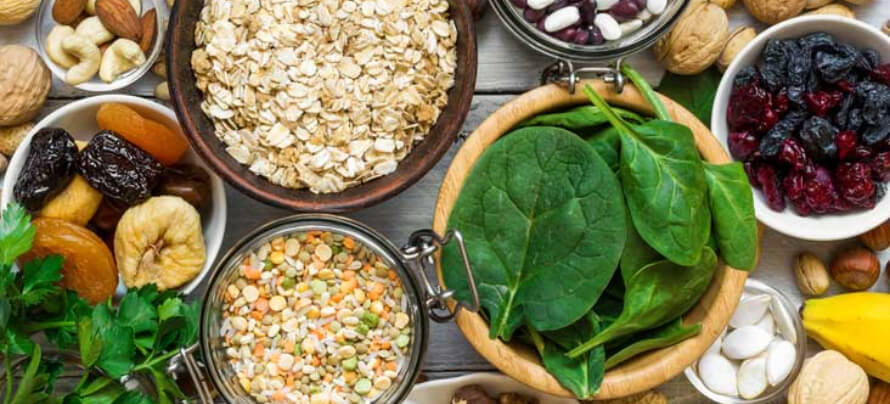Key Takeaways
- Vitamin and mineral deficiencies are states where you aren’t getting as many essential nutrients as we should through our diets.
- While the diet can indeed be modified to get more of these nutrients, that’s not always practical. In these instances, supplementing is better than going for years with an inadequate intake.
- Potassium, vitamin D, and vitamin K are the most common vitamin and mineral deficiencies while magnesium, calcium, and zinc deficiencies can occur depending on your lifestyle.
The best supplements are the least sexy.
If you’re like me then you only really get excited about the new and crazy stuff that comes out of left field and completely blindsides.
Things like extremely potent toxic supplements, foods that are as powerful as supplements, or weird placebo effects and the like.
Antipsychotic tree barks and supplements made from volcanic ashes? That’s real neat-o.
Then you hear about the benefits of vitamin D and you’re all like “Ugh, I KNOW DAD vitamin D is good for you tell me something I don’t know.”
Well kiddo, sit down and eat your peas cause it’s time for a recap of five boring things that you should really be putting in your face. Don’t make me get the pun gun—nobody likes dad jokes gone wild.
Cause let’s be honest, I wouldn’t be surprised if half the readers here are overestimating the micronutrient value of their foods and just assume that their diets are satisfactory.
- What Are Vitamin and Mineral Deficiencies?
- What About Nonessential Nutrients?
- The 5 Most Common Vitamin and Mineral Deficiencies
- How to Fix the 5 Most Common Vitamin and Mineral Deficiencies
- The Bottom Line on Vitamin and Mineral Deficiencies
Table of Contents
+What Are Vitamin and Mineral Deficiencies?
When it comes to the essential vitamins and minerals most discussion simply revolves around “how much” to consume, since it’s assumed we have to consume it anyways.
Now, it’s a surprisingly difficult topic to cover.
The way essential vitamins and minerals, as well as other vitamin-like compounds that are designated non-essential (like CoQ10 or inositol) are not as simple as putting gas into a tank of unchanging volume.
You can’t just hit target X and call it a day.
I mean, we try to simplify it as such when recommending these things but how researchers get “target X” is a dance between absorption rates, elimination rates, assessing what the vitamin or mineral even does in the body, etc.
The ideal doses of these vitamins and minerals can change, not only with your lifestyle and intake of other components. For example, a major role of vitamin D is to manage calcium levels in the body so increasing one does affect the other—vitamin K and phosphorus are also involved.
It was only a decade or so ago that our vitamin D requirements were literally half of what they are now.
With each passing year we learn more about vitamins and minerals, and how much, when, and how to take them, though there are a few principles that more or less stay the same.
The general rules that bind together all things with the label “essential:”
- If you get none in your diet you get some manner of disease state—this is deficiency.
- If you get enough to avoid a disease but your body is functioning in a way that isn’t seen as optimal, and adding more of the vitamin or mineral in question is enough to overcome this suboptimal state—this is insufficiency.
- If your body is functioning in a way that the body no longer benefits from adding more of the vitamin and mineral to it then you are pretty much in the clear—this is sufficiency.
When the supplement industry talks about dietary supplements and vitamin and mineral deficiencies it’s a pretty big misnomer. When people say “deficiency,” most of the time they really mean an “insufficiency.”
Now, how can an insufficiency state harm the body or at least prevent it from performing optimally?
There are 2 major ways that this seems to happen:
- Sometimes you have enough of a vitamin or mineral so that it can do its job, but it’s not working at 100% capacity because there isn’t enough. Plopping in a bit more can increase it to 100% capacity even if 50% is sufficient for health.
- If you have minimal amounts of a vitamin or mineral, the body has likely modified it’s basic function to preserve whatever amounts you already have stored in the body. Your body tweaked its functions for survival, not for optimal function, and corners have been cut.
Regardless, just upping your intake of the essential vitamins and minerals in question basically solves all problems. Easy peasy.
Recommended Reading:
What About Nonessential Nutrients?

Nonessential nutrients refer to things that act like essential vitamins in the body but are not classified as such.
This is mostly because, to being designated an essential vitamin, we need to suffer from a disease state and potentially die when we do not get the nutrient in question—that is what makes it “essential” after all.
Some nutrients, however, either have others help out their function as a safety buffer (taurine is essential to provide sulfur but, without it, we can use other sources) or our bodies can simply synthesize it so we don’t need to rely on ingestion (CoQ10, creatine, and PQQ).
The reason I call them nutrient-like is simply because if you genetically remove them from a rat’s body the rat suffers immensely.
Genetic alterations to prevent creatine formation causes mental retardation, PQQ deficiency (forced by destroying intestinal bacteria) causes all-around reductions in cellular function, etc.
These compounds pop up a fair bit in discussions on vitamins and minerals but, due to not having the essential label do not really have an insufficiency state (although it’s something that we can totally argue about anyways!).
So, the bottom line is that the nonessential nutrients can also be just as respected as the essential vitamins and minerals—just remember that they’re called different things and keep an eye out for both groups.
Recommended Reading:
→ This Is the Definitive Guide to Creatine Monohydrate Supplementation
The 5 Most Common Vitamin and Mineral Deficiencies
The 5 most common vitamin and mineral deficiencies are based on the average diet.
Not all of these will apply to you, maybe none of them will, but on average these are the 5 to look out for when you’re wondering what to supplement with.
Vitamin & Mineral Deficiency #1
Potassium
Potassium is a great example of how something you can’t really be deficient in, but you can be insufficient in.
Potassium is the dietary mineral found in essentially all plant products to a low degree and is commonly seen as the opposite to sodium—all the bad stuff sodium does in excess is stuff that potassium intake can protect against after all.
Now, when it comes to a deficiency state … I’m honestly not even sure if such a thing has been recorded in non-hospitalized individuals. The body seems very anal retentive at preserving as much potassium as it can due to how important it is.
But when comparing otherwise healthy people we see that higher potassium intake is, quite simply, associated with reduced risk of any cardiovascular problem related to blood flow (which is almost all of them.)
Unfortunately it’s not easy to supplement potassium, though. As I explain in this article, legalities prevent there from being a simple pill solution so we need to find some less than practical work-around.
If you have a mixed diet filled with veggies and you’re hitting 80+% of the RDI of potassium then, eh, you’re doing good enough. If, however, you’re hitting 200% the RDA of sodium and don’t eat many veggies then dear God fix that now.
Recommended Reading:
→ What 12 Studies Say About Potassium Deficiency (and What to Do About It)
Vitamin & Mineral Deficiency #2
Vitamin D

Vitamin D is the prototypical vitamin supplement.
There’s great evidence to suggest that …
- We need a lot more than we’re getting.
- It’s very difficult to get it through non-fortified foods for many people due to low sun exposure rates (even in some near-equator nations like Iran or Saudi Arabia.)
- It’s both cheap and relevant enough that MDs and the government alike have changed their tunes to start promoting it.
I mean, there’s so much evidence on this topic that I don’t even know where to begin? Vitamin D just … does almost everything at least a wee bit decently?
It specializes in preventing falls and subsequent problems in the elderly, supporting both bone health, and just enough of the brain’s connection to the muscles to help with muscular function. For us youth it seems to dabble in mood disorders and stress quite a bit, support a good hormonal profile, and has general supportive effects on organ health.
It’s definitely a top 3 supplement to put in your face.
Now, even if superloading vitamin D is a contentious subject (with people taking over 10,000 IU a day or snorting lines of the stuff) there’s nothing wrong with recommending a small increase in your daily intake.
The old RDI value of vitamin D used to be 400 IU, and now at least up here in Canadaland we have 800 IU as our new recommendation.
Generally speaking anything between 800 to 2,000 IU is a good, but modest, suggestion for vitamin D intake. Some people recommend 5,000 IU as well, and that’s fine, though when you get up to this level of intake it’s best to get a blood test to check your levels.
As a general rule, you want your blood levels of vitamin D to be in the range of 54 to 90 ng/mL (or 135 to 225 nM).
The only people who don’t need to supplement vitamin D are those who live near the equator and are outside quite frequently. Equatorial hermits may still need some but, come on, just get out of the house instead.
Recommended Reading:
→ 5 Powerful Vitamin D Benefits That Make It a “Super-Vitamin”
Vitamin & Mineral Deficiency #3
Vitamin K
Vitamin K is an essential vitamin that’s going to be subject to the vitamin D treatment soon …
There’s plenty of evidence to argue that it can benefit from an increase in intake, and it’s personally my favorite topic in this article due to the benefits it could bring!
However, the current state it is in has parallels to the vitamin D situation in the past where new evidence can give rise to the idea that “more is indeed better.” The RDI of 90 to 110 mcg, at least in Western countries, may very well be too low for ideal health.
Vitamin K refers to the molecule phylloquinone, known as K1, and the menaquinone class of molecules—most commonly MK-4 and MK-7. These quinones, when they get into the body, support a series of vitamin K-dependent proteins that can only function well when they have bonded to vitamin K.
The actions of these proteins are, collectively, the health benefits of vitamin K.
While many of these proteins are already chugging along at a good pace and further levels of vitamin K doesn’t help them improve their speed, there’s usually some benefit from more vitamin K.
In particular, osteocalcin and matrix protein gla, which are proteins related to supporting bone health and managing where calcium goes—indirectly being heart healthy as well.
These two proteins seem to function better and better with increasing doses of up to 1,000 mcg of vitamin K1 or 320 to 500 mcg of the MK-7 form which are the highest recommendations I have seen so far.
Prothrombin, another protein that is involved in blood clotting seems to be improved up until about 200 mcg as well.
The benefits of these select proteins becoming more active has been shown to improve arterial and heart health and actively remove calcium from blood vessels. Increasing calcium levels in the blood vessels is linked with atherosclerosis, and reversing this process is generally thought to reduce the risk of having a heart attack.
In this way, vitamin K could help curb the potential side-effects of too much vitamin D and calcium, which includes arterial calcification (a predictor of all-cause mortality in all ages).
At this moment in time the only known side-effect of vitamin K supplementation is in individuals taking warfarin, in which the two are contraindicated. In other words, never take them simultaneously.
Increasing vitamin K intake to at least 250 mcg K1, or up to 1,000 mcg K1, seems to be a prudent idea for cardiovascular and overall health and longevity.
Recommended Reading:
Vitamin & Mineral Deficiency #4
Magnesium

Magnesium is the most common mineral deficiency in the Western world.
The cause is simple, too—it’s due to our poor diets.
Magnesium is widespread in many different food products but usually only in small amounts.
While a good source of vitamin C can provide well over 100% of your requirements and other foods can contain over 50% of your daily needs for calcium per serving (like casein protein), most foods contain 20% or less of your daily magnesium needs per serving.
I mean, the best sources is macadamia nuts which seem to have 130 mg per 100 grams.
That gives you 33% of your RDI for the day … at a staggering low calorie count of 720 calories.
Don’t want that? Prepare to choose at least 5 other magnesium-rich food sources each day.
So yeah, in practice we end up under-consuming magnesium. No biggie though, supplementation can help round it out quite a bit and it’s not overly expensive either.
Now, this is the surprising part.
I am willing to bet that, if you have a healthy diet, normalizing a magnesium insufficiency probably isn’t going to do too much for ya.
Sure, it will be healthy, but I believe that magnesium has been hyped up falsely just to stand beside vitamin D and K.
A bit of this hype likely came from the fact that acute magnesium usage does indeed have strong effects that you get tolerant to pretty fast.
In rats this is antidepressant effects while it’s well known the first dose of magnesium supplementation you ever take knocks you right out into a great sleep.
Over the long run it just falls into the same place as other, boring, minerals. Just get it through food or supplements and call it a day.
Magnesium is a common deficiency and one worth fixing since it’s not super easy to fix simply by dietary modification, especially in a diet where calories are restricted.
While your first time supplementing it is likely going to be associated with a great sleep, long-term supplementation is not as much a panacea as many companies would suggest.
Recommended Reading:
→ The 5 Absolute Best Supplements for Women (#2 and 3 Are Must Haves)
Vitamin & Mineral Deficiency #5
Zinc
Zinc is a mineral that, across the entire Western population, is not commonly a deficiency.
(Globally, however, rates are at 17% inadequate intake reaching 30% in South Asia.)
This is because we not only don’t need too much zinc in our diets, our bodies are pretty good at keeping it inside of us and recycling it as needed.
Zinc plays a vital role as being a part of many enzymes in our bodies, including those directly involved in the creation of DNA and RNA while also playing some antioxidant roles. Many enzymes require minerals attached to them so they can interact with other proteins and zinc fills this role well.
Unless there is a major stimuli that causes zinc to be forcibly lost from the body, or damn near none is eaten, deficiencies are uncommon.
However, many people refer to sweating from exercise as this major stimuli.
Sweating can leach many minerals from our bodies and many athletes think that they have increased rates of zinc deficiency due to this, which ended up being one of the major marketing claims behind ZMA supplementation.
It’s definitely known that exercise causes alterations in zinc balance and, after the workout, there are some losses thought to be related to sweat. Over time, athletes do indeed seem to have lower serum zinc status despite higher oral intake thereof.
It’s uncertain how much athletes need to take, though. While the true answer is probably related to how much you sweat, 15 to 30 mg once daily probably isn’t a bad starting point.
It’s reasonable to conclude that high-intensity athletes that sweat a lot need more zinc, and this supplementation seems to be exclusive to sweaty people rather than an inherent “rule of thumb” for everybody.
How to Fix the 5 Most Common Vitamin and Mineral Deficiencies

In regards to the above common nutrient deficiencies the best ways to alleviate them are:
- Potassium requires dietary changes or potassium hydrochloride (salt substitute.) Eat lots of fruits, vegetables, and seafood.
- Vitamin D can easily be gotten with cheap supplementation or, if you are not too northern or southern on the globe, going outside for prolonged periods of time.
- Vitamin K, at high doses, requires either moderately priced supplements or nattō if you want a convenient source. Otherwise lots of leafy greens are required.
- Magnesium has no super convenient dietary way to get optimal levels. Best you can do is more varied plant sources or pick up some magnesium citrate on the cheap.
- Zinc can be easily solved with a ZMA supplement if you also wanted to get a magnesium supplement, 2 for one resolution right there. If not that then seek out bottom-feeders like oysters.
Thankfully I designed our sport multivitamin, Triumph, to have ideal levels of vitamin D and K while also conferring just as much magnesium and zinc as your typical ZMA supplement. Potassium will still need to be gained through the diet though—legalities and all that.
Triumph contains 35 vitamins, minerals, herbs, and adaptogens to plug nutritional “holes” in your diet, improves your mood and mental and physical performance, and boost your resistance to stress, sickness, and disease.
If that sounds good to you, then you want to check out Triumph today.
The Bottom Line on Vitamin and Mineral Deficiencies
At the end of the day, very few of us are able to get all essential vitamins and minerals without dietary supplementation.
It’s easy to get enough to survive, and reasonable to get enough to thrive, but optimal levels can only be attained with a bit of luck and major attention to diet.
So potassium, magnesium, and zinc as well as vitamins D and K commonly hold us back from our best potential. Supplementing these select vitamins and minerals, on an as needed basis, can really help us in the long run.
While potassium is legally beyond our reach, Triumph helps greatly with the other four.
What’s your take on the most common vitamin and mineral deficiencies? Have anything else to share? Let me know in the comments below!
Scientific References +
- Chu, A., Holdaway, C., Varma, T., Petocz, P., & Samman, S. (2018). Lower Serum Zinc Concentration Despite Higher Dietary Zinc Intake in Athletes: A Systematic Review and Meta-analysis. In Sports Medicine (Vol. 48, Issue 2, pp. 327–336). Springer International Publishing. https://doi.org/10.1007/s40279-017-0818-8
- Chu, A., Petocz, P., & Samman, S. (2017). Plasma/Serum Zinc Status During Aerobic Exercise Recovery: A Systematic Review and Meta-Analysis. In Sports Medicine (Vol. 47, Issue 1, pp. 127–134). Springer International Publishing. https://doi.org/10.1007/s40279-016-0567-0
- Chu, A., Petocz, P., & Samman, S. (2016). Immediate effects of aerobic exercise on plasma/serum zinc levels: A meta-analysis. Medicine and Science in Sports and Exercise, 48(4), 726–733. https://doi.org/10.1249/MSS.0000000000000805
- Maxfield, L., & Crane, J. S. (2021). Zinc Deficiency. In StatPearls. StatPearls Publishing. http://www.ncbi.nlm.nih.gov/pubmed/29630283
- Poleszak, E., Wlaÿ, P., Kêdzierska, E., Radziwon-Zaleska, M., Pilc, A., Fidecka, S., & Nowak, G. (2005). Effects of acute and chronic treatment with magnesium in the forced swim test in rats.
- Tota-Maharaj, R., Blaha, M. J., McEvoy, J. W., Blumenthal, R. S., Muse, E. D., Budoff, M. J., Shaw, L. J., Berman, D. S., Rana, J. S., Rumberger, J., Callister, T., Rivera, J., Agatston, A., & Nasir, K. (2012). Coronary artery calcium for the prediction of mortality in young adults <45 years old and elderly adults >75 years old. European Heart Journal, 33(23), 2955–2962. https://doi.org/10.1093/eurheartj/ehs230
- Booth, S. L., Martini, L., Peterson, J. W., Saltzman, E., Dallal, G. E., & Wood, R. J. (2003). Dietary phylloquinone depletion and repletion in older women. Journal of Nutrition, 133(8), 2565–2569. https://doi.org/10.1093/jn/133.8.2565
- Dalmeijer, G. W., van der Schouw, Y. T., Magdeleyns, E., Ahmed, N., Vermeer, C., & Beulens, J. W. J. (2012). The effect of menaquinone-7 supplementation on circulating species of matrix Gla protein. Atherosclerosis, 225(2), 397–402. https://doi.org/10.1016/j.atherosclerosis.2012.09.019
- Binkley, N. C., Krueger, D. C., Kawahara, T. N., Engelke, J. A., Chappell, R. J., & Suttie, J. W. (2002). A high phylloquinone intake is required to achieve maximal osteocalcin γ-carboxylation. American Journal of Clinical Nutrition, 76(5), 1055–1060. https://doi.org/10.1093/ajcn/76.5.1055
- Alshahrani, F., & Aljohani, N. (2013). Vitamin D: Deficiency, sufficiency and toxicity. In Nutrients (Vol. 5, Issue 9, pp. 3605–3616). MDPI AG. https://doi.org/10.3390/nu5093605
- Fosnight, S. M., Zafirau, W. J., & Hazelett, S. E. (2008). Vitamin D supplementation to prevent falls in the elderly: Evidence and practical considerations. In Pharmacotherapy (Vol. 28, Issue 2, pp. 225–234). Pharmacotherapy. https://doi.org/10.1592/phco.28.2.225
- Daly, R. M. (2010). Independent and combined effects of exercise and vitamin D on muscle morphology, function and falls in the elderly. In Nutrients (Vol. 2, Issue 9, pp. 1005–1017). MDPI AG. https://doi.org/10.3390/nu2091005
- AlQuaiz, A. J. M., Kazi, A., Fouda, M., & Alyousefi, N. (2018). Age and gender differences in the prevalence and correlates of vitamin D deficiency. Archives of Osteoporosis, 13(1). https://doi.org/10.1007/s11657-018-0461-5
- Vatandost, S., Jahani, M., Afshari, A., Amiri, M. R., Heidarimoghadam, R., & Mohammadi, Y. (2018). Prevalence of vitamin D deficiency in Iran: A systematic review and meta-analysis. In Nutrition and Health (Vol. 24, Issue 4, pp. 269–278). SAGE Publications Ltd. https://doi.org/10.1177/0260106018802968
- Liu, X., Baylin, A., & Levy, P. D. (2018). Vitamin D deficiency and insufficiency among US adults: Prevalence, predictors and clinical implications. British Journal of Nutrition, 119(8), 928–936. https://doi.org/10.1017/S0007114518000491
- Rucker, R., Storms, D., Sheets, A., Tchaparian, E., & Fascetti, A. (2005). Biochemistry: Is pyrroloquinoline quinone a vitamin? In Nature (Vol. 433, Issue 7025, pp. E10–E11). Nature. https://doi.org/10.1038/nature03323
- Lion-François, L., Cheillan, D., Pitelet, G., Acquaviva-Bourdain, C., Bussy, G., Cotton, F., Guibaud, L., Gérard, D., Rivier, C., Vianey-Saban, C., Jakobs, C., Salomons, G. S., & Des Portes, V. (2006). High frequency of creatine deficiency syndromes in patients with unexplained mental retardation. Neurology, 67(9), 1713–1714. https://doi.org/10.1212/01.wnl.0000239153.39710.81










